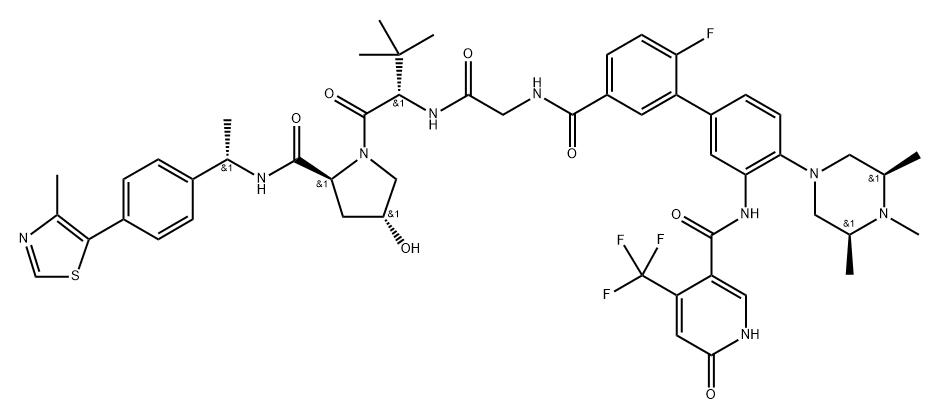| Chemical Properties | Back Directory | [Boiling point ]
1134.6±65.0 °C(Predicted) | [density ]
1.325±0.06 g/cm3(Predicted) | [storage temp. ]
Store at -20°C | [form ]
Solid | [pka]
8.27±0.10(Predicted) | [color ]
White to off-white |
| Hazard Information | Back Directory | [Biological Activity]
MS67 is a potent and selective WD40 repeat domain protein 5 (WDR5) degrader with a Kd of 63 nM. MS67 is inactive against other protein methyltransferases, kinases, GPCRs, ion channels, and transporters. MS67 shows potent acticancer effects[1].
MS67 (0.001-1 μM) induces WDR5 degradation at a concentration as low as 1 nM. MS67 induces WDR5 depletion much more effectively in all six mixed lineage leukemia (MLL)-r acute myeloid leukemia (AML) and four pancreatic ductal adenocarcinoma (PDAC) cell lines without a hook effect and in a concentration-dependent manner in PDAC cells[1].MS67 decreases H3K4me2/3 in both MV4;11 and MIA PaCa-2 cells, whereas other examined histone methylation marks such as H3K9me3, H3K27me3, and H3K36me3 are not affected . MS67 is effective in suppressing both WDR5-related gene expression programs and WDR5/MLL-induced H3K4 methylations on chromatin[1].The GI50 values of MS67 in the two most sensitive AML lines, MV4;11 and EOL-1, are 15 nM and 38 nM, respectively. MLL-r acute leukemia cell lines including MV4;11, EOL-1, MOLM13, KOPN8, RS4;11, and THP-1 are sensitive to MS67, whereas leukemia cell lines that did not harbor MLL-r (including K562, HL60, and a murine AML line transformed by Hoxa9 plus Meis1) are insensitive to MS67[1]..MS67 binds to VCB (VHL-Elongin C-Elongin B ternary complex), with a Kd of 140 nM[1].
MS67 (75 mg/kg; i.p.; twice daily; 5 days a week; for 20 days) significantly inhibits tumor growth in vivo and prolongs survival of the treated mice[1].After a single intraperitoneal (i.p.) injection of MS67 at a dose of 75 mg/kg, the Cmax reached at about 4.2 μM, and the concentration of MS67 retained above 0.5 μM over 12 hours[1]. | [References]
[1]. Xufen Yu, et al. A selective WDR5 degrader inhibits acute myeloid leukemia in patient-derived mouse models. Sci Transl Med. 2021 Sep 29;13(613):eabj1578. |
|
|





